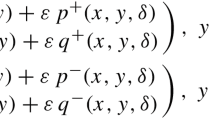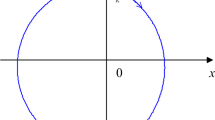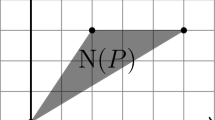Abstract
In this paper, we study the creation of zeros in a certain type of families of functions. The families studied are given by the difference of two basic functions with a translation made in the argument of one of these functions. The problem is motivated by applications in the 16th Hilbert problem and its ramifications. Here, we apply the results obtained to the study of bifurcations of critical periods in the Loud family of quadratic centers.


Similar content being viewed by others
References
Cherkas LA. The stability of singular cycles. (Russian) Differ Uravnenija 1968;4:1012–1017.
Chicone C, Jacobs M. Bifurcation of critical periods for plane vector fields. Trans Amer Math Soc 1989;312:433–486.
Goursat Ed. Sur la théorie des fontions implicites. Bullet SMF 1903; 31:184–192.
Il’yashenko Y, Yakovenko S. Finite cyclicity of elementary polycycles in generic families. Concerning the Hilbert 16th problem, 21–95, Amer. Math. Soc. Transl. Ser. 2, vol 165. Amer. Math. Soc., Providence; 1995.
Mañosas F, Villadelprat J. The bifurcation set of the period function of the dehomogenized Loud’s centers is bounded. Proc Amer Math Soc 2008;136: 1631–1642.
Mardešić P, Marín D, Villadelprat J. Unfolding of resonant saddles and the Dulac time. Discret Contin Dyn Syst 2008;4:1221–1244.
Mardešić P, Marín D, Villadelprat J. On the time function of the Dulac map for families of meromorphic vector fields. Nonlinearity 2003;16 (3):855–881.
Mardešić P, Vol. 57. Chebyshev systems and the versal unfolding of the cusps of order n. Travaux en Cours [Works in Progress]. Paris: Hermann; 1998, p. xiv+ 153.
Mardešić P, Marín D, Villadelprat J. The period function of reversible quadratic centers. J Differ Equ 2006;224:120–171.
Mardešić P, Marín D, Saavedra M, Villadelprat J. Unfoldings of saddle-nodes and their Dulac time. J Differ Equ 2016;261:6411–6436.
Marín D, Villadelprat J. On the return time function around monodromic polycycles. J Differ Equ 2006;228:226–258.
Marín D, Villadelprat J. Asymptotic expansion of the Dulac map and time for unfoldings of hyperbolic saddles: local setting. J Differ Equ 2020;269: 8425–8467.
Marín D, Villadelprat J. Asymptotic expansion of the Dulac map and time for unfoldings of hyperbolic saddles: general setting, preprint.
Marín D, Villadelprat J. Asymptotic expansion of the Dulac map and time for unfoldings of hyperbolic saddles: coefficients formulas, in preparation.
Mourtada A. Degenerate and non-trivial hyperbolic polycycles with two vertices. J Differ Equ 1994;113(1):68–83.
Mourtada A. bifurcation de cycles limites au voisinage de polycycles hyperboliques et génériques à trois sommets. (French) [Bifurcation of limit cycles near generic hyperbolic polycycles with three vertices]. Ann Fac Sci Toulouse Math (6) 1994;3(2): 259–292.
Mourtada A, Vol. 1455. Cyclicité finie des polycycles hyperboliques de champs de vecteurs du plan: mise sous forme normale. (French) [Finite cyclicity in normal form of the hyperbolic polycycles of vector fields of the plane] Bifurcations of planar vector fields (Luminy, 1989), 272–314, Lecture Notes in Math. Berlin: Springer; 1990.
Mourtada A. cyclicité finie des polycycles hyperboliques de champs de vecteurs du plan. Algorithme de finitude. (French) [Finite cyclicity of hyperbolic polycycles of planar vector fields. Finiteness algorithm]. Ann Inst Fourier (Grenoble) 1991;3: 719–753.
Roussarie R. A note on finite cyclicity property and Hilbert’s 16th problem. Dynamical systems, Valparaiso 1986, 161–168, Lecture Notes in Math. Berlin: Springer; 1331, p. 1988.
Roussarie R. On the number of limit cycles which appear by perturbation of separatrix loop of planar vector fields. Bol Soc Brasil Matx 1986;17(2):67–101.
Rojas D. On the upper bound of the criticality of potential systems at the outer boundary using the Roussarie-Ecalle compensator. J Differ Equ 2019;267: 3922–3951.
Rojas D. Asymptotic development of an integral operator and boundedness of the criticality of potential centers. J Dyn Diff Equat 2020;32(2):665–704.
Rojas D, Villadelprat J. A criticality result for polycycles in a family of quadratic reversible centers. J Differ Equ 2018;264:6585–6602.
Roussarie R, Vol. 164. Bifurcation of planar vector fields and Hilberts sixteenth problem, Progress in Mathematics. Basel: Birkhuser; 1998, p. xviii+ 204.
Saavedra M. Dulac time of a resonant saddle in the Loud family. J Differ Equ 2020;269:7705–7729.
Villadelprat J. On the reversible quadratic centers with monotonic period function. Proc Amer Math Soc 2007;135:2555–2565.
Funding
P. Mardešić is supported by Croatian Science Foundation (HRZZ) grant PZS-2019-02-3055 from Research Cooperability funded by the European Social Fund and by EIPHI Graduate School (contract ANR-17-EURE-0002). D. Marín is supported by the Ministry of Science, Innovation and Universities of Spain through the grants MTM2015-66165-P and PGC2018-095998-B-I00, by the Agency for Management of University and Research Grants of Catalonia through the grant 2017SGR1725, and by the “María de Maeztu” Programme for Units of Excellence in R&D (MDM-2014-0445). J. Villadelprat is supported by the grants MTM2017-86795-C3-2-P and 2017SGR1617.
Author information
Authors and Affiliations
Corresponding author
Additional information
Publisher’s Note
Springer Nature remains neutral with regard to jurisdictional claims in published maps and institutional affiliations.
A Appendix
A Appendix
We put in the Appendix some classical results that we need, as well as some specific technicalities
1.1 A.1 Classical Results
We start with Goursat’s version of the implicit function theorem which requires continuous differentiability only with respect to the variable that we isolate.
Theorem A.1
[3] Let X be an open subset of \({\mathbb {R}}^{n}\) and let W be an open subset of \({\mathbb {R}}^{k}\). Consider (x0, w0) ∈ X × W and \({\Phi }:X\times W\to {\mathbb {R}}^{k}\) be such that
-
(a)
Φ(x0, w0) = 0;
-
(b)
Φ(x, w) is continuous on X × W;
-
(c)
∂wΦ(x,⋅) is continuous on W, for all x ∈ X;
-
(d)
∂wΦ(x0, w0) is surjective.
Then there exist a neighborhood X1 × W1 of (x0, w0) and a function ϕ : X1 → W1 such that ϕ(x0) = w0 and for every (x1, w1) ∈ X1 × W1 we have Φ(x1, w1) = 0 if and only if w1 = ϕ(x1). Moreover, ϕ is continuous.
Lemma A.2
Let {fμ}μ∈U be a continuous family of functions on (0, s0) and let K ⊂ U be a compact set. Then \(\lim _{s\to 0^{+}}f_{\mu }(s)=\ell (\mu )\), uniformly on μ ∈ K, if and only if \(\lim _{(\mu ,s)\to (\hat \mu , 0^{+})}f_{\mu }(s)=\ell (\hat \mu )\), for every \(\hat \mu \in K\).
Proof
Assume that \(\lim _{s\to 0^{+}}f_{\mu }(s)=\ell (\mu )\), uniformly on μ ∈ K. Then μ↦ℓ(μ) is continuous on K. Let us show now that, under the uniformity assumption, fμ(s) tends to \(\ell (\hat \mu )\), as \((s,\mu )\longrightarrow (0^{+},\hat \mu )\). Consider a given ε > 0. Then, thanks to the claim, there exists a neighborhood \(\mathscr U\) of \(\hat \mu \) such that \(\left |{\ell (\mu )-\ell (\hat \mu )}\right |<\varepsilon /2\) for all \(\mu \in \mathscr U\). Furthermore, on account of the uniformity, there exists δ > 0 such that \(\left |{f_{\mu }(s)-\ell (\mu )}\right |<\varepsilon /2\) for all s ∈ (0, δ) and \(\mu \in \mathscr U\). Consequently,
and so \(\lim _{(\mu ,s)\to (\hat \mu , 0^{+})}f_{\mu }(s)=\ell (\hat \mu ),\) as desired. Suppose now that \(\lim _{(\mu ,s)\to (\hat \mu , 0^{+})}f_{\mu }(s)=\ell (\hat \mu )\), for every \(\hat \mu \in K\). Then the map (s, μ)↦fμ(s) extends continuously to [0, s0/2] × K, which is compact. So the map is uniformly continuous, which clearly implies that \(\lim _{s\rightarrow 0^{+}}f_{\mu }(s)=\ell (\mu )\) is uniform on K. This proves the result. □
It will be convenient in order to apply the implicit function theorem, to work with functions defined in an open neighborhood of the origin. For that reason, we extend monotone function \(\hat f_{\mu }\) defined on a one-sided neighborhood of the origin to an odd function \(\hat f_{\mu }\) defined in a full neighborhood of the origin.
Lemma A.3
Let {fμ}μ∈U be a continuous family of functions on (0, s0) with \(\lim _{s\to 0^{+}}f_{\mu }(s)=0\) uniformly on U. For each μ ∈ U, we define
Then \(\{\hat f_{\mu }\}_{\mu \in U}\) is a continuous family of functions on (−s0, s0). If in addition s↦fμ(s) is monotonous on (0, s0), for all μ ∈ U, then \(\{\hat f^{-1}_{\mu }\}_{\mu \in U}\) is a continuous family of functions on (−s1, s1), for some s1 > 0.
Proof
The continuity of \((s,\mu )\longmapsto \hat f_{\mu }(s)\) at some \((\hat s,\hat \mu )\in (0,s_{0})\!\times U\) is obvious, for \(\hat s\neq 0\), whereas, for \(\hat s=0\), it follows by applying Lemma A.2. Suppose additionally that fμ is monotonous on (0, s0) for all μ ∈ U. Then \(\hat f_{\mu }\) is monotonous on (−s0, s0) for all μ ∈ U. Accordingly \((s,\mu )\longmapsto (\hat f_{\mu }(s),\mu )\) is an injective continuous map from the open set \((-s_{0},s_{0})\!\times U\subset \mathbb {R}^{k}\) to \(\mathbb {R}^{k}\). Then, by the Domain Invariance Theorem, it follows that there exists s1 > 0 such that \(\{\hat f^{-1}_{\mu }\}_{\mu \in U}\) is a continuous family of functions on (−s1, s1). Hence, the result is proved. □
1.2 A.2 Technicalities
Recall (4) that ω is a deformation of the logarithmic function. The first claim of the following lemma is the deformation of the fomula for the logarithm of a product for the function ω.
Lemma A.4
The following hold:
-
(a)
ω(ab; α) = a−αω(b; α) + ω(a; α),
-
(b)
\(\frac {1}{\omega (s;\alpha )}\to \frac {|\alpha |-\alpha }{2}\), as s → 0+ uniformly on α ≈ 0,
-
(c)
Let α↦λ(α) be a continuous map at α = 0. Then 1 ≺0sλ(α)ω(s; α), if and only if λ(0) > 0.
-
(d)
\(|\frac {\partial \omega }{\partial \alpha }/\omega ^{2}|\) is bounded.
Proof
The equality in (a) is straightforward taking the definition of ω(s; α) into account. The assertion in (b) follows easily from the inequality \(\omega (s;\alpha )\geqslant \inf (-\log s,1/|\alpha |)\), cf. [18, S3]. Concerning (c), the sufficiency follows writing the compensator as \(\omega (s;\alpha )=F(\alpha \log s)\log s\), where \(F(x)\!:=\frac {e^{-x}-1}{x}\), and using that \(|{F(x)}|\leqslant e^{|x|}\) for all \(x\in \mathbb {R}.\) To show the necessity we use Lemma A.2, which implies that \(\lim _{(\alpha ,s)\to (\hat \alpha , 0^{+})} s^{\lambda (\alpha )}\omega (s;\alpha )=0\) for any \(\hat \alpha \in [-\delta ,\delta ]\) with δ > 0 sufficiently small. Clearly this is not possible if \(\lambda (0)\leqslant 0\) because then \(s^{\lambda (0)}\omega (s;0)=s^{\lambda (0)}\log s\) tends to \(-\infty \) as s→0+. Thus λ(0) > 0, and so (c) follows. Claim (d) follows from Lemma 4.1.1 in [8]. □
Remark A.5
If \(\lim _{s\to 0^{+}}{\Psi }_{1}(s;\mu )=L(\mu )\) and \(\lim _{s\to 0^{+}}{\Psi }_{2}(s;\mu )=0\), with both limits being uniform on μ, then \(\lim _{s\to 0^{+}}{\Psi }_{1}\bigl ({\Psi }_{2}(s;\mu );\mu \bigr )=L(\mu )\), uniformly on μ.
We shall deal with two types of families of admissible functions, \(\{s^{\lambda }\}_{\lambda >0}\) and {sω(s; α)}α≈ 0, both defined in principle, for s > 0. It is clear that each function fλ(s) = sλ in the first family is monotonously increasing and that, by applying Lemma A.3, {fλ}λ> 0 and \(\{f_{\lambda }^{-1}\}_{\lambda >0}\) can be continuously extended to (−s0, s0) for some s0 > 0. It is obvious in addition that \(f_{\lambda }^{-1}(s)=s^{1/\lambda }\). In the following result we show analogous properties for the second family.
Lemma A.6
Set fα(s) = sω(s; α). Then the following hold:
-
(a)
fα(ab) = a1−αfα(b) + bfα(a),
-
(b)
There exists s0 > 0 and ε > 0 such that {fα}α∈(−ε, ε) is a continuous family of monotonous increasing functions on (0, s0) with \(\lim _{s\to 0^{+}}f_{\alpha }(s)=0\), uniformly on α ∈ (−ε, ε). In addition \(\{f^{-1}_{\alpha }\}_{\alpha \in (-\varepsilon ,\varepsilon )}\) is a continuous family of functions on (0, s0), with \(\lim _{s\to 0^{+}}f^{-1}_{\alpha }(s)=0\), uniformly on α ∈ (−ε, ε).
-
(c)
\(f_{\alpha }^{-1}(s)\sim _{0} \frac {s\kappa (\alpha )}{\omega (s;\alpha /(1-\alpha ))}\), where \(\kappa (\alpha )\!:=(1-\alpha ) \alpha ^{\frac {\alpha +|\alpha |}{2(1-\alpha )}}.\)
Proof
The equality in (a) is straightforward taking the definition of ω(s; α) into account. The monotonicity in (b) follows using that, by (b) in Lemma A.4, \(f_{\alpha }^{\prime }(s)=-1+(1-\alpha )\omega (s;\alpha )\) tends to \(+\infty \) as (α, s) → (0, 0+). The fact that fα(s) tends to zero as s → 0+ uniformly on α is a consequence of (c) in Lemma A.4. Taking this into account, the assertion concerning \(f_{\alpha }^{-1}\) follows by applying Lemma A.3. In order to show (c), setting \(\alpha ^{\prime }\!:=\frac {\alpha }{1-\alpha }\), we first claim that
tends to κ(α) as s→0+ uniformly on α ≈ 0. Note that (c) will follow once we prove this claim. Indeed, since \(\lim _{s\to 0^{+}}f^{-1}_{\alpha }(s)=0\) uniformly on α ≈ 0 by (b), we get the desired conclusion, by applying Remark A.5, with \({\Psi }_{2}(s;\alpha )=f^{-1}_{\alpha }(s).\)
In order to prove the claim, we apply Lemma A.2. To this end note that \(\kappa (\alpha _{0})=(1-\alpha _{0})\alpha _{0}^{\frac {\alpha _{0}}{1-\alpha _{0}}}\), if α0 > 0, κ(0) = 1 and κ(α0) = 1 − α0, if α0 < 0. If α0≠ 0, then, by definition,
which clearly tends to 1 − α0, as (α, s)→(α0, 0+), in case that α0 < 0. If α0 > 0, then for convenience we write the above equality as
which tends to \((1-\alpha _{0})\alpha _{0}^{\frac {\alpha _{0}}{1-\alpha _{0}}}\), as (α, s)→(α0, 0+). It only remains to see that \(\frac {\omega (s\omega (s;\alpha );\alpha ^{\prime })}{\omega (s;\alpha )}\longrightarrow 1\) as (α, s)→(0, 0+). With this aim in view, some manipulations show that
where we take \(\alpha ^{\prime }=\frac {\alpha }{1-\alpha }\) into account several times. Note that
due to \(\omega (s;\alpha )\geqslant \inf (-\log s,1/|\alpha |).\) Moreover, \(\omega (s;\alpha )=F(\alpha \log s)\log s\), where recall that \(F(x)=\frac {e^{-x}-1}{x}\) verifies that \(|{F(x)}|\leqslant e^{|x|}\), for all \(x\in \mathbb {R}.\) Accordingly, for x > 1 and \(\alpha ^{\prime }\in [-\frac {1}{2},\frac {1}{2}]\), we can assert that
Hence, \(\frac {\omega (x;\alpha ^{\prime })}{x}\longrightarrow 0\), as \(x\longrightarrow +\infty \), uniformly on \(\alpha ^{\prime }\in [-\frac {1}{2},\frac {1}{2}]\). This, together with (31), implies that
because \(\alpha ^{\prime }=\frac {\alpha }{1-\alpha }\longrightarrow 0\) as α→0. Therefore, on account of (30), we finally obtain
as desired. This proves the claim and so the result follows. □
Remark A.7
By Lemma A.3, each family \(\{s^{\alpha }\}_{\alpha >0}\) and {sω(s; α)}α≈ 0 extends to a continuous family of homeomorphisms \(\{\hat f_{\alpha }\}\) on (−s0, s0) with \(\hat f_{\alpha }(0)=0\). Their respective inverses form also a continuous family of functions \(\{\hat f^{-1}_{\alpha }\}_{\alpha }\) on (−s1, s1) for some s1 > 0. In the sequel, by an abuse of notation and when there is no risk of ambiguity, we will denote \(\hat f\) and \(\hat f^{-1}\) by f and f− 1, respectively.
Lemma A.8
The Dulac time T−(s; F) of the Loud family (5) restricted to the line D + F = 0 between the transverse sections {x = 0} parametrized by \(\sigma (s)=\left (0,\frac {1-s}{\sqrt {F(F-1)}}\right )\) and {y = 0, x < 0} satisfies the following:
-
(a)
For every F0 > 3/2, there is δ > 0, such that \(T_{-}(s;F)=T_{00}(F)+T_{01}(F)s^{r(F)}+{\mathcal {F}}_{r(F_{0})+\delta }^{\infty }(F=F_{0})\) with \(r(F)=\frac {1}{2(F-1)}\) and
$$T_{01}(F)=-F^{-\frac{F}{F-1}}2^{\frac{1}{2(F-1)}}\sqrt{F(F-1)}\sqrt{\pi}\frac{\Gamma(1-r(F))}{\Gamma(\frac{1}{2}-r(F))}.$$In particular, T01(F) = −(F − 2)U01(F) with U01(2) > 0.
-
(b)
\(T_{-}(s;F)=T_{00}(F)+T_{01}(F)s^{r(F)}+T_{101}s\omega \left (s;\frac {F-2}{F-1}\right )+T_{100}(F)s+{\mathcal {F}}_{3/2-\delta }^{\infty }(F=2)\) with T101(2) > 0.
Proof
We perform the projective change of coordinates \((u,v)=\phi (x,y)=(1-\sqrt {F(F-1)}\frac {y}{1-Fx},\frac {1}{1-Fx})\) which brings the Loud vector field (x − 1)y∂x + (x + F(y2 − x2))∂y into \(X_{F}=\frac {1}{v}[P_{F}(u,v)u\partial _{u}+Q_{F}(u,v)v\partial _{v}]\) where \(P_{F}(u,v)=\sqrt {\frac {F-1}{F}}(u-2)(v-1)\) and \(Q_{F}(u,v)=\frac {1}{\sqrt {F(F-1)}}(u-1)((F-1)v+1)\) and the transverse sections x = 0 and y = 0 into v = 1 and u = 1 respectively. The hyperbolicity ratio of the saddle of XF at (u, v) = (0, 0) is \(r(F)=\frac {1}{2(F-1)}<1\) for F > 3/2. This gives us the announced expansion in (a). Let us now compute the coefficient T01(F). In the coordinate chart (u, v) the parametrization σ(s) translates into σ(s) = (s, 1) and we can take the parametrization τ(s) = (1, s) in the target transverse section. By applying [7, Theorem A], after some tedious but straightforward computations, we obtain that
thanks to the formula \({{\int \limits }_{0}^{1}}\left ((1-\frac {u}{2})^{-a}-1\right )\frac {du}{u^{a}}=\frac {2^{a-1}\sqrt {\pi }{\Gamma }(2-a)}{(1-a){\Gamma }(\frac {3}{2}-a)}-\frac {1}{1-a}\) in which appears the Gamma function Γ. In particular, \(\frac {\Gamma (1-r(F))}{\Gamma (\frac {1}{2}-r(F))}=\frac {\sqrt {\pi }}{2}(F-2)+O((F-2)^{2})\).
To prove (b), it suffices to take F ≈ 2 where the announced asymptotic expansion holds by [13, Theorem A]. In fact, we have \(T_{-}(s)=T_{00}+T_{01}s^{r}+T_{10}s+T_{02}s^{2r}+{\mathcal {F}}_{2r_{0}+\delta }(r=r_{0})\) if \(r_{0}>\frac {1}{2}\) and T101 = (1 − 2r)T02, T100 = T10 + T02 so that
By [14, Theorem A]
with
and
Since \(1-(1/r-1)=\frac {1-2r}{-r}\) we have that
using [14, Theorem B.1] in the first equality. □
Rights and permissions
About this article
Cite this article
Mardešić, P., Marín, D. & Villadelprat, J. Bifurcations of Zeros in Translated Families of Functions and Applications. J Dyn Control Syst 28, 121–150 (2022). https://doi.org/10.1007/s10883-020-09520-3
Received:
Revised:
Accepted:
Published:
Issue Date:
DOI: https://doi.org/10.1007/s10883-020-09520-3




